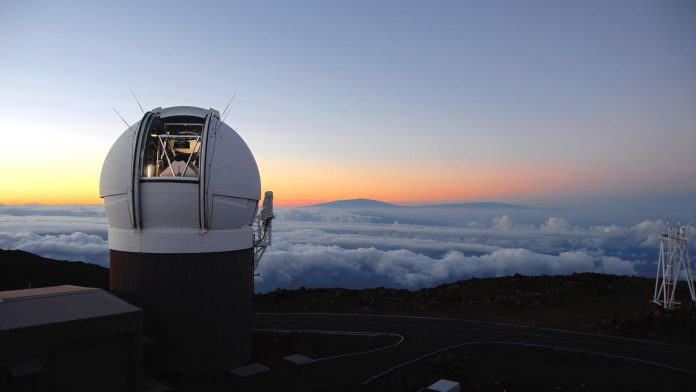
The Pan STARRS system, located in Haleakala in Hawaii, is the world’s largest and most powerful digital cameras.
Funded by NASA’s Near-Earth Object Observation Program, it is currently employed to hunt and track potentially dangerous space objects.
What are the Pan STARRS Telescopes?
The Panoramic Survey Telescope and Rapid Response System, Pan STARRS for short, is a system for wide-field astronomical imaging, developed and operated by the Institute of Astronomy at the University of Hawaii. It is located at the Haleakala Observatory (cited on a massive shield volcano on Maui) in Hawaii and consists of astronomical cameras, telescopes, and associated computing facilities.
The telescope’s purpose is to survey the night sky, on a continual basis, for moving or variable objects, and to also gather accurate astrometric and photometric data on previously-detected objects.
“The complete Pan STARRS system will use the world’s largest digital camera—with 1.4 gigapixels—to survey the entire sky visible from Hawaii roughly once a week. This vast survey is expected to discover thousands of supernovae, greatly increasing the number of data points on the Hubble diagram and therefore increasing the precision with which we know the expansion history of the universe and its acceleration rate.” – Learner.org.
Construction
It was built as part of a collaboration between the University of Hawaii Institute for Astronomy, the MIT Lincoln Laboratory, the Maui High-Performance Computing Center, and the Science Applications International Corporation. The institutions form the PS1 Science Consortium, which together fund the operation of the Pan-STARRS1 telescope, for the purposes of astronomical research. Construction of the 1.8 meter diameter telescope was funded by the United States Air Force.
According to Pan-STARRS, “The PS1 consortium is made up of astronomers and engineers from 14 institutions from six countries. Pan-STARRS is a system for wide-field astronomical imaging developed and operated by the Institute for Astronomy at the University of Hawaii. Pan-STARRS1 (PS1) is the first part of Pan-STARRS to be completed. The PS1 survey uses a 1.8-meter telescope and its 1.4 Gigapixel camera to image the sky.”
PS1 went online in December of 2008, with full-time scientific observations begining in May of 2010. With this phase complete, the focus turned to the construction of a second telescope PS2.
A second telescope, Pan-STARRS2 (P2) was also built using funding from NASA’s Near-Earth Object Observation Program. It is similar in design to PS1 with the exception that it has a slightly larger camera, with 1.5 billion pixels.
7 fascinating facts about the Pan-STARRS Telescope
-
Pan-STARRS1 and 2 are the world’s leading Near-Earth Object detection telescopes. The telescopes include some of the world’s largest-ever digital cameras, with more than one billion pixels apiece.
- Pan-STARRS1 (PS1) was the first to be built and consists of a 1.8-meter diameter telescope. It is located near the summit of Haleakala on the island of Maui. Pan-STARRS2 (PS2) was built adjacent to PS1 and has a slightly larger, 1.5 billion pixel camera.
- Pan-STARRS1 and 2 have made some significant discoveries since their inception, including the ‘Oumuamua asteroid.
- Pan-STARRS is expected to detect and discover hundreds of thousands of asteroids and other near-Earth objects within our Solar System. This will likely include objects like Jupiter trojan asteroids, Kuiper belt objects and asteroids associated with Saturn, Uranus, and Neptune.
- The project is also expected to discover many objects outside of our Solar System. This could possibly include objects such as variable stars, supernovae and, information that will help astrophysicists determine whether dwarf galaxies actually exist.
- The lion’s share of its funding comes from the NASA Near-Earth Object Observations program. For this reason, most of its time is devoted to the hunt for these, and similar, objects.
- The project’s second data release, Pan-STARRS DR2 is the largest astronomical data set ever released. It contained more than 1.6 petabytes of images, which is equivalent to around 30,000 times the amount of content on Wikipedia.















































